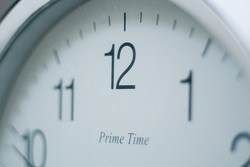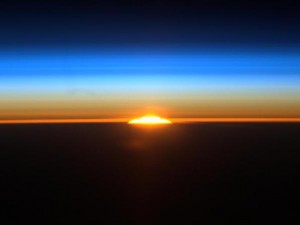Create a free profile to get unlimited access to exclusive videos, sweepstakes, and more!
Wait just a second! No really, wait JUST A SECOND

Today is the great Leap Second Day, when an extra second is added to our clocks at midnight. For one odd moment, the official time will actually go from June 30 at 23:59:59 to 23:59:60 instead of directly to July 1 at 00:00:00.
The reason this is done is because the atomic clock standard we use has a very slightly different rate than the rotation-of-the-Earth based Coordinated Universal Time system. To be clear: it's not that the Earth is slowing down so much we have to add a second every couple of years! It's that they run at different rates, so we have to compensate by throwing in the odd leap second now and again.
This has been planned for some time, and in fact I wrote about this in excruciating detail in January. Because there is simply no way I can top the brilliance of that post, I'll simply repost it here. It's a bit long, but that's OK: you have an extra second today to read it.
[Reposted from "Wait just a (leap) second" from January 23, 2012.]  This summer will be a little bit longer than usual. A tiny little bit: one second, to be precise. The world's official time keepers are adding a single second to the clocks at the end of June. This "leap second" is needed to keep various time scales in synch. It's a bit of a pain and won't really affect people much, but if it weren't done things would get messy eventually.
This summer will be a little bit longer than usual. A tiny little bit: one second, to be precise. The world's official time keepers are adding a single second to the clocks at the end of June. This "leap second" is needed to keep various time scales in synch. It's a bit of a pain and won't really affect people much, but if it weren't done things would get messy eventually.
This gets a bit detailed -- which is where the fun is! -- but in short it goes like this. We have two systems to measure time: our everyday one which is based on the rotation of the Earth, and a fancy-schmancy scientific and precise one based on vibrations of atoms. The two systems aren't quite in synch, though, since the Earth counts a day as a tiny bit longer than the atomic clocks say it is. So every now and again, to get them back together, we add a leap second on to the atomic clocks. That holds them back for one second, and then things are lined up once again.
There. Nice and simple. But that's spackling over all the really cool details! If you want a little more info, you can read the US Naval Observatory's press release on this (PDF).
If you want the gory details, then sit back, and let me borrow a second of your time.
Time after time There are lots of ways of keeping time. The basic unit day is based on the physical rotation of the Earth, and year is how long it takes to go around the Sun. But we need finer units than those! So we decided long ago to divide the day into 24 hours, and those into 60 minutes each, and those into 60 seconds each. In that case, there are 86,400 seconds in a day. OK, easy enough.
For most of us, that is enough. But scientists are picky (or "anal" if you want to be technical) and like to be more precise than that. And the thing is, the Earth is a bit of a sloppy time keeper. Tidal effects from the Sun and Moon, for example, slow it a bit. Other effects come in as well, changing the rate of the Earth's rotation.
To account for this, in 1956 the International Committee for Weights and Measures made a decision: we'll base the length of the second on the year, not the day. In fact, we'll take the year as it was in the year 1900 (a nice round number, so why not) and say that the length of the second is exactly 1/31,556,925.9747 of the year as measured at the beginning of January 1900*.
OK, fine. Now scientists have their
anal precise definition, normal people have calendars, and we're all happy, right?Right?
Sunrise, sunset
Yeah. Not so much. Defining the second as a fraction of a year is fine and all, but it kind of leaves the unit of "day" out in the cold. To define that, we use what's called a mean solar day, which is essentially the time it takes for the center of the Sun's disk to pass a point in the sky twice. So basically look at the Sun, mark its position and note the time, and wait for it to pass that point in the sky again. That's a solar day.
 But this doesn't depend on the second or the year! And remember, the length of the day is slowly increasing. You can ask yourself - and you should - hey, when were there exactly 86,400 seconds (as we now define them based on the year 1900) in one solar day? Because if the day is getting longer, there are more seconds in a day now than there were a hundred years ago.
But this doesn't depend on the second or the year! And remember, the length of the day is slowly increasing. You can ask yourself - and you should - hey, when were there exactly 86,400 seconds (as we now define them based on the year 1900) in one solar day? Because if the day is getting longer, there are more seconds in a day now than there were a hundred years ago.
The answer, it turns out is in the year 1820. More or less, but close enough. Back then, a solar day had 86,400 of these new-fangled seconds in it. But that's not true any more. The Earth has been slowing, the day getting longer, and now, almost two centuries later, there are about 86,400.002 seconds in a day.
Yup. The day has 2 extra milliseconds in it. That may not sound like much, but it adds up. Over the course of a single year we have an extra 365 of those 2 millisecond slices of time. That adds up to about 0.73 seconds every year. After a year, the calendar is off by about 3/4 of a second because the Earth's rotation is slow. In two years that's 1.46 seconds, and after ten years it's over 7 seconds!
We can't have that, obviously. But what can you do?
The Atomic Age
In 1972 a new timekeeping system was adopted: Coordinated Universal Time, or UTC, based on an atomic clock. The idea is that atoms are pretty good timekeepers, and in particular a cesium atom makes an excellent clock (I describe why here). In a sense using an atomic clock makes it unnecessary to use the Earth as a clock... but we humans have this pesky desire to use clocks in our everyday lives, and to base them on things like sunrise and sunset -- in other words the Earth's rotation (the aforementioned system, which is called Universal Time 1 or UT1).
 And we know the Earth's rotation is a bit slower than it was, and every year we have these dangling 0.73 seconds. That means that the Earth time is lagging behind the atomic time by that much every year.
And we know the Earth's rotation is a bit slower than it was, and every year we have these dangling 0.73 seconds. That means that the Earth time is lagging behind the atomic time by that much every year.
The fix for that is to add leap seconds when needed. The International Earth Rotation and Reference Systems Service (IERS) are the folks who keep track of these things, and they decided that when the lag between UT1 and UTC gets to be more than 0.9 seconds, they add a leap second to the end of a convenient month, and the two get back to being much closer in synch.
That's why we were adding one at the end of June.
And we're done. Right?
Right?
Stop the Earth, I wanna get off!
Nope. I want to clear up a misconception (used by creationists sometimes) first... and then I have to add one more thing. Some people think that because we have to add leap seconds every year or so, the Earth must be slowing by a tremendous rate. But that's not the case: the reason we add leap seconds is because the two time systems have clocks that tick at different rates, essentially. It's not much, but over time it adds up. I've written about this before:
Imagine you have two clocks. One thinks there are 86,400 seconds in a day, the other thinks that there are 86,401, so the second clock runs a tad bit slower than the first. Every day, itâs one second behind, clicking over to midnight one second after the first clock does. Mind you, it keeps accurate time according to its own gears: every day has 86,401 seconds, so itâs not slowing down.However, to keep it synchronized with the other clock, weâd either have to subtract a second from the second clock (yikes, terminology is a bit confusing there!) or add one to the first clock every day. So weâd need a leap second every day, but not because the clock is slowing. Itâs only because it runs at a different (but constant) rate.”
So it's not that the Earth is slowing down so much. If the Earth were to maintain its current spin rate from now on, we'd still have to add leap seconds every now and again, because it's running slow. In that case, we could simply insert leap seconds at regular intervals and everyone's happy.
But there's still one more thing. Of course there is.
Staggering seconds
The final issue is that the Earth isn't slowing at a constant rate. There are a lot of factors that change the Earth's spin -- weather, damming rivers, earthquakes, and so on -- that add up over time. So it's not just that the Earth is slow compared to an atomic clock, but also that the amount it's slow changes! We can't just add a leap second every 15 months or whatever; we have to watch the Earth's spin carefully and add them in as needed. Since 1972 when all this started, there have been 24 leap seconds added to atomic clocks. Sometimes the interval between them has been less than a year, and sometimes it's been quite a bit more. The last one was added on December 31, 2008.
Cutting the cord
After all this, you might be wondering why we bother. Why not just decouple the two clocks, and let them go their separate ways?
A lot of scientists do in fact feel this way. But it turns out to be really, really complicated to do that. A lot of computer systems (including satellite navigation systems) have software written a while ago, and changing that would be difficult and have unforeseen consequences. Fiddling with that may be dangerous.
At a recent meeting of the American Astronautical Society, there was a session on this topic. A paper was written (PDF) giving an overview of it. It gets a little technical, but it might make for interesting reading for any chronological geeks out there.
I think I lean toward the present system of keeping the systems in tune by using leap seconds. It's a small price to pay for having our own internal clocks based on the spinning planet.
... but I wonder. There will come a day when we leave this planet for others. The Moon, Mars, and beyond. When we do, we'll have to worry about timekeeping there as well. We do have one for Mars, but it will have the same inherent problems we do now.
It's actually kind of neat: there may -- there will -- be a time when we do need a truly Universal time system. What will we do then?
Images courtesy of zoutedrop's Flickr stream; NASA; Ozymandias.
* There are different ways of measuring the year, too so they went with a tropical year, which was a pretty decent choice.
Related posts:
- Take a flying leap second
- Followup: leap seconds
- Another orbit? Why, you don't look a rotation older than 4.56 billion years!
- Why we have leap days (one of my favorite posts of all time)














